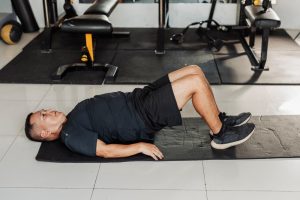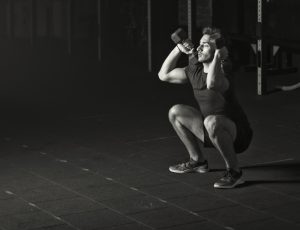If you want a bigger, stronger back, the five best exercises are the deadlift, pull-up, bent-over row, T-bar row, and seated cable row.
Each one targets key muscles across your upper and lower back to build both width and thickness—keep reading to see exactly how they work and how to use them effectively.
Why Back Training Deserves More Attention Than You Think
Most lifters give plenty of focus to chest, arms, or abs—but the back doesn’t always get the same attention.
That’s a big mistake. Your back plays a central role in how you move, how you look, and how strong you can actually get.
The Back: A Structural and Functional Powerhouse
Your back isn’t just one big muscle—it’s a complex system of interconnected muscle groups that work together to stabilize your body, support your spine, and generate power in nearly every major movement.
Whether you’re deadlifting, throwing, sprinting, or even sitting upright at your desk, your back is involved.
A well-trained back contributes directly to:
- Posture: Strong spinal erectors and traps help maintain an upright, neutral posture, reducing slouching and the long-term wear it causes.
- Athletic performance: Movements like sprinting, jumping, and throwing all rely on a powerful posterior chain—especially the lats, traps, and spinal stabilizers.
- Lifting strength: The back supports virtually every heavy lift, even those not considered “back exercises.” Without it, your deadlifts, squats, and even bench press suffer.
Back Width vs. Back Thickness
If your goal is to look like you lift, this part matters.
Back width and back thickness are two different visual elements, and both need focused training.
- Back width refers to how wide your back looks from the front or rear—mostly driven by the development of the latissimus dorsi. Think V-taper.
- Back thickness is about depth—how dense and muscular your back looks from the side. This is built by targeting the mid-back muscles: rhomboids, traps, and spinal erectors.
Focusing only on pull-ups and lat pulldowns might help with width, but without rows or deadlifts, your back can end up looking flat.
A complete routine needs exercises that emphasize both dimensions.
The Mistakes That Keep Your Back From Growing
It’s common to hit a plateau with back training, not because you’re not working hard, but because you’re working inefficiently.
Three big pitfalls get in the way:
- Poor technique: Many lifters pull with their arms or swing through reps, missing proper scapular retraction and full range of motion. Without precise control, your back muscles don’t get fully engaged.
- Neglecting the mid-back: Exercises like barbell rows, T-bar rows, and cable rows are often skipped in favor of easier machines. But it's the mid-back that gives your back its detailed, muscular appearance.
- Overreliance on machines: Machines have their place, but they often stabilize too much of the movement for you. Free weights and bodyweight movements demand more from your stabilizers, giving better overall development.
What You Gain From Prioritizing Back Training
A well-developed back delivers more than just visual impact. It plays a crucial role in your body's structural integrity and long-term performance:
- Better balance: Training the back helps offset front-dominant training like chest and shoulder work, reducing the risk of postural imbalances or shoulder injuries.
- More strength carryover: A strong back supports virtually every compound lift. Improving your rows and pulls often leads to better squats, presses, and even core work.
- Injury prevention: Strengthening the muscles around your spine and shoulder blades stabilizes your entire upper body. This protects your joints during heavy lifting and daily movement.
When you understand just how involved your back is in everything you do—both in and out of the gym—it becomes clear why ignoring it holds you back.
Prioritize it, train it smart, and the payoff will be visible and measurable.
Exercise 1 – Deadlift: Build Full-Chain Strength and Thickness
The deadlift isn't just a back exercise—it’s a full-body movement that starts at your heels and finishes with your traps.
But when done right, it's also one of the most powerful tools for building back thickness, especially in the spinal erectors, rhomboids, and traps.
What the Deadlift Really Works
While the glutes and hamstrings often get the spotlight in deadlifts, the upper and mid-back carry a serious load—literally.
Your spinal erectors keep your torso from collapsing forward under heavy weight.
Your lats and traps stabilize and support the bar throughout the lift, while your rhomboids help keep your scapulae pinned together.
Even the lats, often trained with pull-ups or pulldowns, are activated isometrically to keep the bar close to your body. In short, the deadlift builds thickness up and down your posterior chain.
Dialing In Your Form
Getting the most out of the deadlift—and avoiding injury—comes down to tight, efficient technique.
First, brace your core hard as if preparing to be punched. This stabilizes your spine and transfers force better through your whole body.
As you initiate the pull, keep the bar close to your shins—almost dragging along your legs.
A vertical bar path reduces the load on your lower back and keeps leverage in your favor.
Drive with your hips and legs, not your arms. If your elbows are bending during the lift, you’re either pulling with your arms or setting yourself up for a bicep tear.
Your arms should act like straps—tight and straight.
At the top, lock out by squeezing your glutes, not by leaning back.
Mistakes That Kill Your Progress (and Your Back)
One of the most common deadlift errors is rounding the lower back.
This puts unnecessary stress on the lumbar spine and shifts the load away from the muscles you're trying to train.
Another issue is yanking the bar off the floor with your arms, which not only reduces back activation but also opens the door to injury.
A third, more subtle problem: losing tension at the bottom.
Resetting between reps without staying tight through the core and lats means you’re starting every rep from a weak, unsafe position.
Controlled reps with full tension are where the gains (and safety) live.
Choosing the Right Deadlift Variation
While the conventional deadlift is the gold standard for overall strength and thickness, other variations can target specific muscles or accommodate individual mobility and build.
- Sumo Deadlift: With a wider stance and more upright torso, the sumo variation reduces shear force on the lower back and shifts more emphasis onto the glutes and inner thighs. It’s also a great option for lifters with longer torsos or limited hip mobility.
- Romanian Deadlift (RDL): This version keeps your legs straighter and emphasizes the eccentric stretch in the hamstrings and glutes. It’s not about moving big weight, but about feeling a deep pull through the posterior chain and building muscular control.
Each variation has its place depending on your goals, structure, and experience.
If you're after complete back development, conventional deadlifts should be the cornerstone, while sumo and Romanian deadlifts are smart additions to address specific weaknesses or limitations.
In the context of back training, deadlifts do more than build size—they build the structural strength your entire program stands on.
Exercise 2 – Pull-Up: The Foundation of Back Width
When it comes to building a wide, V-shaped back, nothing beats the pull-up.
It’s one of the most straightforward movements you can do—but when performed correctly, it lights up your lats and upper back like few other exercises.
How Pull-Ups Build Width and Control
The pull-up primarily targets the latissimus dorsi, the large wing-like muscles responsible for back width.
But they also activate supporting muscles including the teres major, rhomboids, and parts of the trapezius, making them more than just a lat-builder.
Because you're moving your entire body weight through space, you’re also engaging stabilizers that get left out of machine-based work.
Pull-ups are especially effective for developing the outward flare that gives your upper body a broader, more athletic look—something cable machines alone often fail to deliver.
The overhead pulling angle hits the lats from a top-down direction, which complements horizontal rowing movements that tend to focus more on thickness.
Grip Adjustments: What Changes When You Switch It Up
The pull-up's effectiveness also comes from its flexibility.
Your grip width and orientation can shift emphasis from one part of your back to another, or even involve other muscle groups:
- A wide grip pull-up reduces arm involvement and puts more mechanical tension directly on the outer lats. This grip tends to be harder, but it's great for maximizing width.
- Chin-ups, with an underhand grip, bring the biceps more into the movement and allow for a slightly greater range of motion. They’re ideal if you're still building pulling strength or want to combine arm and back work.
- A neutral grip (palms facing each other) is often easier on the shoulders and elbows while still delivering solid lat activation. It’s especially helpful if you're recovering from joint issues or looking for long-term joint health.
Rotating between these grips can help avoid overuse injuries and ensure balanced development.
How to Maximize Lat Engagement with Proper Form
Execution is where most people go wrong with pull-ups. The most common mistake?
Turning it into a kipping or half-rep mess that reduces lat activation and increases joint strain.
To do them right, start from a dead hang, with your arms fully extended and your shoulders set down—not shrugged up.
Think about pulling your elbows down and in, rather than just lifting your chin over the bar.
This helps activate the lats more fully.
Keep your torso steady—no swinging or kicking—and focus on squeezing your shoulder blades together at the top.
Finish each rep by lowering under control to a full stretch; cutting the bottom short robs your lats of valuable range and growth potential.
Also important: scapular depression.
Before you initiate each rep, slightly pull your shoulders down and away from your ears.
This shifts the load off the traps and puts it where it belongs—on the lats.
Which Pull-Up Variation Should You Use?
All variations have a place, and which one you use depends on your training focus:
- Wide-Grip Pull-Up: Prioritizes lat width. Ideal for upper-level trainees with strong pulling mechanics.
- Chin-Up (Underhand Grip): Great for adding volume, building arm strength, and progressing toward bodyweight mastery.
- Neutral-Grip Pull-Up: Easier on the joints and a solid option for high-rep work or if shoulder mobility is limited.
If you can't yet do bodyweight pull-ups, assisted pull-up machines or resistance bands can help build strength without compromising form.
But the goal should always be full control through each phase of the movement.
Pull-ups aren't just a test of strength—they’re a benchmark of control and muscular coordination.
Mastering them pays off with broader lats, better posture, and a stronger upper body overall.
Exercise 3 – Bent-Over Row: Mid-Back Density Builder

If you want your back to look thick and muscular from every angle, the bent-over row needs to be in your routine.
It’s one of the few lifts that directly targets the mid-back with enough loading potential to really drive growth.
Why the Bent-Over Row Builds Dense Muscle
Unlike vertical pulls like pull-ups or pulldowns, bent-over rows use a horizontal pulling motion.
That change in angle shifts the emphasis to the rhomboids, middle trapezius, and the lower lats—muscles that add depth to your back and give it that three-dimensional look.
Your posterior delts and spinal erectors also play a supporting role, stabilizing your upper body throughout the lift.
This kind of targeted tension is exactly what’s needed to build density—especially in the often-undertrained middle portion of the back.
It’s not just about size; a strong mid-back also plays a key role in posture, shoulder health, and upper-body stability during heavy pressing movements.
Positioning and Control Make or Break This Lift
One of the most important parts of performing a bent-over row effectively is setting your body angle correctly.
Start by hinging at the hips, not rounding your back, and lowering your torso until it’s roughly parallel to the floor—or slightly higher if mobility is limited. Your spine should stay flat and neutral from neck to hips.
Throughout the lift, your chest should stay open, and your shoulders retracted, but not shrugged.
You want to row the bar or dumbbells toward your lower ribs or upper waist, not your chest.
Pulling too high shifts the focus to your traps and away from the mid-back.
And don’t use momentum. If you have to jerk the weight to get it moving, it’s too heavy—or you’ve lost core tension.
Controlled reps with a tight core and minimal body movement will always yield better results than sloppy, swinging reps with more weight.
Choosing the Right Variation
The bent-over row isn’t one-size-fits-all. Each variation has its strengths depending on what you’re trying to improve.
- Barbell Bent-Over Row: Ideal for loading. It allows you to use heavier weight, which is great for hypertrophy and strength. Just make sure to keep your form locked in, especially as the weight climbs.
- Dumbbell Bent-Over Row: Excellent for fixing muscle imbalances. Because each arm moves independently, it’s easier to spot and correct strength or range-of-motion differences between sides. You’ll also get more freedom of movement in the shoulder joint, which can help if you’re tight or dealing with past injuries.
- Pendlay Row: A stricter, more explosive version where the bar resets on the ground between every rep. It reinforces proper pulling mechanics from a dead stop and forces you to use power from your lats and mid-back rather than momentum.
If you’re training for size, rotating between these variations can help you target the same muscles with different stimuli.
For example, start your training cycle with barbell rows to focus on load, then switch to dumbbells or Pendlay rows later to refine technique and fix weaknesses.
The bent-over row doesn’t just build a stronger back—it teaches control, coordination, and total-body tension.
Get this lift right, and you’ll see it carry over into almost every other upper-body movement you do.
Exercise 4 & 5 – T-Bar Row and Seated Cable Row: Targeted Mass and Control
T-Bar rows and seated cable rows might look similar on paper—they're both horizontal pulls—but they serve very different purposes in a well-rounded back workout.
When used together, they offer a balance of heavy loading and precise control, making them a powerful combo for building both size and muscular coordination.
Why These Two Exercises Work So Well Together
The T-Bar row is all about load.
It allows you to move serious weight through a stable, mid-back-focused range of motion.
With your body hinged forward, you're able to activate your lats, rhomboids, and traps with minimal assistance from your lower body, especially if you maintain proper core tension.
On the other hand, the seated cable row focuses on constant tension and control.
Because the cable system keeps resistance steady throughout the entire movement, you’re forced to slow down, control the pull, and truly isolate the working muscles.
It's particularly effective for refining technique and building a strong mind-muscle connection—something that's often lost when chasing heavy weights alone.
Combining these two lifts gives you the best of both worlds: strength and hypertrophy, power and precision.
T-Bar Row: Technique and Setup
To get the most from the T-Bar row, set your torso at about a 45-degree angle.
Too upright and you shift stress onto your traps and arms; too low and you risk losing tension in your core and lower back.
Keep your chest up, spine neutral, and core tight throughout the lift.
As you pull, aim to bring the handle into your lower chest or upper abs, squeezing your shoulder blades together at the top.
Don’t let the weight yank your shoulders forward at the bottom—maintain scapular control through the full range of motion.
Both machine T-Bar rows and landmine setups can work here.
Machines typically offer more stability and a fixed path, which is great for hypertrophy focus.
Landmine versions give you more flexibility in grip and angle, allowing you to better tailor the movement to your structure and goals.
Seated Cable Row: Control, Consistency, and Customization
The seated cable row might not look as intense as a T-Bar row, but it plays a critical role in back development.
Sit upright with your spine neutral and avoid leaning too far forward or backward.
Start the pull by retracting your shoulders, not just bending your elbows—this ensures you’re leading with your back, not your arms.
At the top of the movement, squeeze your shoulder blades together, then slowly return to a full stretch.
The key here is tempo—fast, jerky reps defeat the purpose.
This lift thrives on consistency and time under tension.
Where seated rows really shine is in the variety of grips and angles you can use:
- A wide grip shifts emphasis outward, hitting more of the upper lats and rear delts.
- A narrow, neutral grip focuses on the inner back, especially the rhomboids and lower traps.
- Single-arm rows are perfect for isolating one side at a time, fixing imbalances, and improving control.
Switching grips every few weeks can help hit the back from multiple angles without changing the core movement.
How to Program Them Together
If you're including both in a single session, use the T-Bar row earlier, when you're fresh and can move heavier loads with solid form.
Follow with the seated cable row later in the workout to focus on squeezing, control, and pushing your back muscles close to fatigue.
Used together, these two exercises help round out your back training with both mechanical tension and precise muscular engagement—two ingredients you need if you're serious about long-term progress.
Programming Your Back Workout for Growth
Once you know which exercises to use, the next step is building a routine that delivers consistent progress.
Back development isn't just about lifting heavy—it’s about applying the right volume, using smart progression, and maintaining solid technique over time.
How Often Should You Train Back?
For most people, training your back once or twice per week is enough to make noticeable progress—as long as the sessions are structured well.
If you’re training it once a week, the session should be more comprehensive and higher in volume.
If you’re hitting it twice, you can split the work between heavier, compound-focused training and lighter, more controlled volume work.
A good example would be a Monday–Thursday split, where Day 1 focuses on heavy rows and deadlifts, and Day 2 emphasizes cable work and pull-ups for volume and muscle activation.
Setting the Right Volume and Rep Ranges
The sweet spot for hypertrophy (muscle growth) is generally 3–4 working sets per exercise in the 8–12 rep range.
This range balances mechanical tension with enough total work to drive muscle adaptation.
That said, deadlifts are often better performed in the 5–8 rep range, especially when going heavy, since they’re neurologically and physically demanding.
Movements like cable rows or pull-ups can stay closer to 10–12 reps where control and time under tension matter more.
How and When to Apply Progressive Overload
Muscles grow when they’re challenged beyond what they’ve already adapted to.
That means you need to progressively overload over time—either by increasing weight, adding reps, or improving technique and range of motion.
Here’s a simple approach:
- If you complete 12 clean reps with your current weight, increase the load slightly in your next session.
- If your form is breaking down before reaching 8 reps, reduce the weight and focus on control.
- If weight isn’t increasing, focus on slowing the tempo or extending the squeeze at the top of the rep. This still creates new stimulus without adding stress to the joints.
Consistency matters more than chasing bigger numbers every week.
Steady progression over months beats inconsistent ego lifting.
Why Technique Always Comes First
Back training is especially easy to mess up if form isn’t your priority.
Using momentum, short-changing the range of motion, or pulling with your arms instead of your back not only limits gains—it increases your injury risk.
Here’s what to look for in every rep:
- Full stretch and full contraction
- Stable spine and engaged core
- Controlled, smooth movements (no jerking or swinging)
When you do it right, lighter weights can actually feel harder—and that’s a good sign you’re hitting the target muscles correctly.
Sample Back Workout Using All Five Key Exercises
Here’s a sample workout you can use once or twice per week.
This structure hits the entire back—upper, mid, and lower—with a balance of strength, volume, and control:
Back Workout Template
- Deadlift – 3 sets of 5–8 reps
Focus on full-body tension and powerful hip drive. Rest 2–3 minutes between sets. - Pull-Up (Wide-Grip or Neutral) – 3 sets of 8–12 reps
Use assistance if needed to maintain full range. Rest 60–90 seconds. - Barbell or Dumbbell Bent-Over Row – 3 sets of 8–10 reps
Control the tempo and aim for a strong mid-back squeeze. - T-Bar Row – 3 sets of 8–12 reps
Moderate-to-heavy weight, focus on maintaining posture and scapular retraction. - Seated Cable Row (Narrow or Single-Arm) – 3 sets of 10–12 reps
Finish with slow, controlled reps to maximize time under tension.
If you're doing a second session in the week, reduce the deadlift intensity or swap it for Romanian deadlifts, and rotate in variation grips for pull-ups and cables.
Keep the structure, adjust the tools.
Smart programming doesn’t just grow muscle—it keeps you injury-free, consistent, and moving forward.
Build around these principles, and your back won’t just get bigger—it’ll get stronger, too.
Conclusion
Building a bigger back takes more than just showing up—it requires smart exercise selection, proper form, and consistent progression.
The five movements covered here target every major area of your back, balancing size, strength, and control.
Stick with them, train with intention, and your results will follow.







